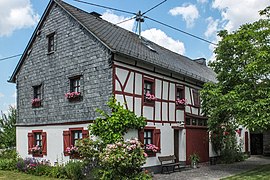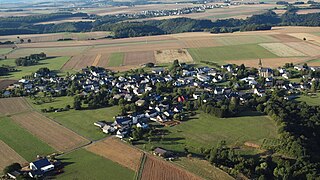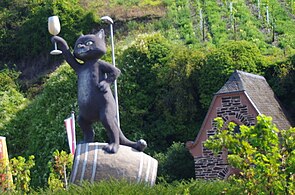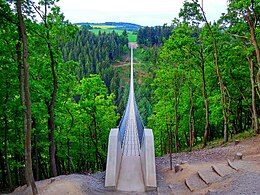District of Cochem-Zell
| coat of arms | Germany map |
|---|---|

|
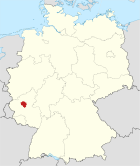
Coordinates: 50 ° 8 ' N , 7 ° 11' E |
| Basic data | |
| State : | Rhineland-Palatinate |
| Administrative headquarters : | Cochem |
| Area : | 692.33 km 2 |
| Residents: | 61,375 (Dec. 31, 2019) |
| Population density : | 89 inhabitants per km 2 |
| License plate : | COC, ZEL |
| Circle key : | 07 1 35 |
| NUTS : | DEB16 |
| Circle structure: | 89 municipalities |
| Address of the district administration: |
Endertplatz 2 56812 Cochem |
| Website : | |
| District Administrator : | Manfred Schnur ( CDU ) |
| Location of the district of Cochem-Zell in Rhineland-Palatinate | |
The district of Cochem-Zell is a regional authority in the northern center of the state of Rhineland-Palatinate . It is the second smallest district in Rhineland-Palatinate in terms of population and the fifth smallest in the Federal Republic of Germany . The seat of the district administration and at the same time the most populous city is Cochem , Germany's smallest district town .
In the district there is the Kaiser Wilhelm Tunnel, one of the longest railway tunnels in Germany between Cochem and Ediger-Eller , the only Glauber salt thermal bath in Germany in Bad Bertrich and the steepest vineyard in Europe on the Calmont near the local community of Bremm . Excellent wines grow in the district on the Moselle. The " Zeller Schwarze Katz " from the Zell district is famous .
geography
location
The district of Cochem-Zell is located in the middle of northern Rhineland-Palatinate and is sparsely populated. The Moselle flows through the center of the district . North of the river is the Eifel , south of it the Hunsrück . About half of the district is covered with forest. The district borders in a clockwise direction in the north, starting with the districts of Mayen-Koblenz , Rhein-Hunsrück-Kreis , Bernkastel-Wittlich and Vulkaneifel .
Natural space
The district has varied landscapes, ranging from the Altlayer Switzerland over the Moselle valley to the maars in the Eifel. Parts of the district belong to the UNESCO Geopark "Vulkaneifel" .
There are deposits of slate in the district (Moselle slate and Hunsrück slate).
cities and communes
(Residents on December 31, 2019)
Association municipalities with their association members:
(Seat of the association *)
- Former parishes
The following municipalities have lost their independence since the district was founded on June 7, 1969:
- Kennfus , on January 1st, 1975 in Bad Bertrich
- Löffelscheid , on November 7, 1970 at Peterswald -akenbofelscheid
- Peterswald , on November 7, 1970 at Peterswald -akenbofelscheid
For lists of the term "area changes" see area reforms in Rhineland-Palatinate
Population development
| year | Residents | source |
|---|---|---|
| 1970 | 66,000 | |
| 1980 | 61,800 | |
| 1990 | 61,900 | |
| 2000 | 65,700 | |
| 2010 | 63,409 | |
| 2016 | 61,864 |
The district of Cochem-Zell will be severely affected by demographic change in the medium and long term. Starting from the base year 2017, the State Statistical Office calculates various scenarios that are based on the same assumptions about natural population growth and only differ with regard to the assumptions about migration behavior.
For the year 2040, the population projections show a decrease in the population to 54,238 inhabitants in the lower variant (−12.0%), 56,724 inhabitants in the middle variant (−8.0%) and 58,904 inhabitants in the upper variant (−4, 5%). In addition, the change in the age structure is to be expected, leading to an increase in the older population. The group of older residents aged 65 and over is the only age group that will record an increase and grows between 30.5% and 33.8% depending on the variant.
A long-term view up to the year 2070 shows an even greater decline in the population, from the expected 42,305 inhabitants (−31.4%) in the lower variant to 49,323 inhabitants (−20.0%) in the middle variant up to 55,647 inhabitants (−9.8%) in the upper variant is enough.
Environment and climate
The area of the district is 692 km² and around 87% of it is covered by vegetation. Almost half of the district area (48%) is covered by forest, which makes the district one of the most wooded regions in the already very wooded Rhineland-Palatinate.
Around three quarters of the area is part of the "Moselle from Schweich to Koblenz" conservation area .
Nature reserves within the meaning of the Federal Nature Conservation Act are:
- Shower relay ,
- Dortebach Valley ,
- Ediger Laach ,
- Falkenlay ,
- Wet meadow at the Schafstaller Hof ,
- Taubengrün Island ,
- Jungferweiher,
- Gravel pit at Mühlenstein,
- Müllenbachtal / Kaulenbachtal,
- Pomeranian ,
- Treiser's shock,
- Ulmen Maar ,
- Juniper heather Nassenberg .
In addition, four protected assets are designated as protected landscape components (gLB). These are the heathland on Leitzenbacher Berg, the pond on Reiserheck, the oaks at the quarry (Gillenbeuren) and the gravel pit in the community forest Hinter Kail.
In the district there is a small bird sanctuary at the Jungferweiher as well as the two large areas "Forests between Wittlich and Cochem" and "Central and Lower Moselle". Parts of the district are flora-fauna habitats (FFH). These include a. the "Altlayer Bachtal" or the "Moselle slopes and side valleys of the lower Moselle". There are a total of six areas, some of which are very small and some of them cross-district. Taken together, bird protection areas and FFH areas form the EU-wide network of protected areas Natura 2000 .
In the Moselle valley, numerous deeply cut, narrow and wooded notch valleys as well as some very steep valley slopes create special climatic conditions. These lead to unique biotopes with partly Mediterranean flora (e.g. boxwood). There are also good conditions for quality viticulture. In the small-scale and large-scale dry biotope locations, warmth and drought-loving species settle, some of which are endangered or threatened with extinction. These include the Rock Bunting , the green lizard or the Mosel Apollo butterfly , which can be found in this particular subspecies world only the Lower Moselle.
Climate protection
Climate protection has played an important role in the Cochem-Zell district for years. As early as 2003, the district administration of Cochem-Zell formulated in its "Local Agenda 21" the goal of wanting to cover the energy demand with renewable energies. In 2008, the district council decided that the district of Cochem-Zell should develop into a “zero-emissions district”. Accordingly, the "Cochem Protocol" was signed in 2009, in which a large number of actors declared their intention to protect the climate, and in 2010, climate protection management was introduced in the district administration. In 2012 the association “Unser-klima-cochem-zell eV” was founded with the statutory task of “promoting climate protection and sustainable development in the district”. Between 2009 and 2015, the district was a subsidized bioenergy region and implemented appropriate measures.
The “Master Plan 100% Climate Protection” from 2017 is the current climate protection concept. The climate goals are a 95% reduction in CO² and a 50% reduction in final energy consumption by 2050 (based on the reference year 1990). The master plan also contains the corresponding program of action.
The climate protection activities are showing successes: Since 2012, the district of Cochem-Zell has been self-sufficient in terms of electricity. H. he can cover all his electricity needs from renewable energies.
history
The current district of Cochem-Zell came under Prussian administration in 1815 , and in 1816 the two districts of Cochem and Zell were established in the Coblenz administrative district . As part of the Rhineland-Palatinate district reform (Third State Law on Administrative Simplification in the State of Rhineland-Palatinate of November 12, 1968) , today's Cochem-Zell district was newly formed from the Cochem district and a substantial part of the Zell district on June 7, 1969. The Mastershausen community came to the Rhein-Hunsrück district on November 7, 1970.
As part of a regional reform in Rhineland-Palatinate, the municipalities of Lahr , Mörsdorf and Zilshausen moved from the district of Cochem-Zell to the Rhein-Hunsrück district on July 1, 2014 .
politics
District council
The district council of the district of Cochem-Zell consists of 38 district council members elected in a personalized proportional representation and the full-time district administrator as chairman. After the last district election on May 26, 2019 , the following distribution of seats results:
| choice | SPD | CDU | AfD | FDP | GREEN | THE LEFT. | FWG | total |
| 2019 | 9 | 16 | 3 | 2 | 4th | 0 | 4th | 38 seats |
| 2014 | 9 | 20th | 2 | 1 | 2 | 1 | 3 | 38 seats |
| 2009 | 9 | 19th | - | 3 | 2 | - | 5 | 38 seats |
| 2004 | 8th | 21st | - | 2 | 1 | - | 6th | 38 seats |
| 1999 | 10 | 24 | - | 2 | 2 | - | - | 38 seats |
Due to the special features of the Rhineland-Palatinate municipal electoral law ( personalized proportional representation ), the percentage of votes shown in the diagram are shown as “weighted results”, which can only represent the voting behavior arithmetically.
District Administrator
Manfred Schnur (CDU) has been the district administrator of the Cochem-Zell district since November 1, 2007. In the direct election on June 21, 2015, he was confirmed in office for a further eight years with a share of the vote of 69.52%.
badges and flags
The district of Cochem-Zell has a coat of arms as well as a hoist and banner flag .
| Blazon : “Diagonal left divided: in front in silver a continuous red cross, covered with a silver horn with a gold strap; behind in black a growing, red armored, tongued and crowned golden lion. " | |
| The reason for the coat of arms: The red cross stands for the Electorate of Trier , the Horn for the Braunshorn dominion in Beilstein with large holdings in the district and the lion for the Count Palatine of Aachen, who ruled the district from 866 to 1150. The coat of arms was awarded on April 20, 1970. |
administration
The seat of the district administration and at the same time the most populous city is Cochem , Germany's smallest district town . The Cochem-Zell district administration employs around 380 people (as of 01/2020).
As of the end of 2019, the municipality is considered to be a pioneer in promoting the Online Access Act .
economy
The economic output in the district of Cochem-Zell is at a GDP of € 1,910 million, the gross value added at production prices is accordingly € 1,722 million. There is a clear focus on the service sector. The gross value added is primarily generated in the service sector (76%), followed by the manufacturing industry (22%) and agriculture and forestry (2%). The service sector is above average compared to the average in Rhineland-Palatinate, which u. a. is due to tourism.
In the district of Cochem-Zell there are 2,900 companies with 16,787 employees. Most of the companies are small in size. 88.5% of the companies have a maximum of 9 employees, 9.6% of the companies have 10–49 employees and 1.3% of the companies have 50–249 employees. Only 0.4% of the companies (eleven companies) have more than 250 employees.
The commuting behavior of employees leads to a negative commuter balance (−4,140). There are a total of 10,466 out-commuters and 6,326 in-commuters. There are strong commuter ties, especially with the district of Mayen-Koblenz and the city of Koblenz.
The commercial space in the district of Cochem-Zell is characterized by low location costs. The average assessment rate is 367.45% and thus z. Sometimes below the values of the neighboring districts and significantly below the values in the nearest metropolitan areas (Koblenz, Trier). The same applies to the acquisition costs of the commercial space.
In the Future Atlas 2016 , the district of Cochem-Zell was ranked 295 out of 402 districts, municipal associations and independent cities in Germany, making it one of the regions with a “balanced risk-opportunity mix” for the future. In the 2019 edition, it was ranked 183 out of 401.
In the FOCUS MONEY economic ranking, the district ranks 178th out of 374 cities and districts in 2019. Compared to the previous year, the district has thus improved by 40 places. In the state evaluation, the district of Cochem-Zell is in the front area (12th out of 31) and is among others. a. in front of the cities of Koblenz and Mainz.
In 2014, the regional representatives of the Koblenz Chamber of Commerce and Industry, the Koblenz Chamber of Skilled Crafts, the Employment Agency, the District Craftsmen's Association, the Cochem Vocational School and the Cochem-Zell District Administration initiated the business network “Future Alliance-Cochem-Zell (ZaC)”.
tourism
Tourism in the district of Cochem-Zell is based on a centuries-old cultural landscape and outstanding sights. In the district are u. a. the steepest vineyard in Europe with the associated via ferrata, the only Glauber salt thermal bath in Germany in Bad Bertrich and the Reichsburg in Cochem (more on this under "Culture and Leisure"). There are other first-class offers especially in the areas of hiking, cycling, wine / culinary art and culture. On the basis of these tourist offers, tourism developed into the most important economic branch in the district.
According to the 2018 statistics, 546 businesses belong to the hospitality industry. This corresponds to 20.5% of all businesses, which is considerably above the average in Rhineland-Palatinate (8.9%). Tourism in turn increases sales in other sectors, e.g. B. in retail, so that there are significant secondary effects for the entire region.
In Rhineland-Palatinate, the district plays a special role as a tourist center: the district of Cochem-Zell is the region with the highest tourism intensity in Rhineland-Palatinate. The district is visited by over 700,000 guests every year. So there are approx. 2.3 million overnight stays. The companies provide a total of almost 18,000 beds.
Depending on the sub-region, the district can be assigned to one of three tourist destinations: Eifel, Mosel, Hunsrück.
Viticulture and wine industry
s. also Moselle (wine-growing area)
The wine industry is a key sector in the district of Cochem-Zell, because it is not only important as a separate branch of the economy, but is also a cornerstone of tourism. Viticulture is crucial for the unique and touristy cultural landscape (hiking trails) and creates offers that tourists like to take advantage of (wine tastings, covered wagon rides, etc.). Viticulture also fulfills an ecological function and secures habitats for rare, often xerophilic, species.
The wines from the “ Zeller Schwarze Katz ” and Bremmer Calmont , the steepest vineyard in Europe, are well known. The Bremmer Calmont and the Ediger Elzhofberg are among the Grand Cru vineyards according to Hugh Johnson .
traffic
Traffic in the district of Cochem-Zell is heavily influenced by motorized individual traffic (MIT). About 96.6% of the traffic flows are handled via the motorized vehicle. Another 0.4% of the traffic flows to the local public transport (ÖPNV).
Road traffic
The federal motorway 48 (Trier – Koblenz) touches the northern district area and can be reached on four driveways. The A48 also offers a connection to the A1 (Saarbrücken - Cologne), the A3 (Frankfurt - Cologne) and the A61 (Venlo - Hockenheim triangle). In addition, the district area runs through several federal and district roads, including the B 49 , B 259 , B 421 and B 416 .
License Plate
On June 7, 1969, the district was assigned the COC , which has been valid since July 1, 1956 for the Cochem district. It is still issued today. Since November 15, 2012, the distinguishing mark ZEL ( Zell (Mosel) ) has been available in connection with the license plate liberalization .
Rail transport
For rail traffic, there are nine train stations and stops in a circle, including the Treis-Karden , Cochem and Bullay stations with local transport connections to Bad Bertrich, Frankfurt-Hahn Airport , Traben-Trarbach and Zell (Mosel).
The main line Koblenz – Trier , opened by the Prussian State Railway in 1879, follows the Moselle valley as far as Pünderich , but cuts a large river loop in the "Kaiser Wilhelm Tunnel" between the district town of Cochem and Ediger-Eller, crosses the Moselle and runs through the Petersberg near Neef and penetrates the narrow mountain spur of the "Prinzenkopf" between Bullay and Pünderich. In the former Pünderich DB station, the branch line to Traben-Trarbach, which opened in 1883, separates from the main line.
The Moselbahn AG route began in Bullay in 1905 and followed all the bends in the river up to Trier. It also touched the former district town of Zell (Mosel) until passenger traffic in 1961 and goods traffic in 1962 were discontinued. In the north of the district, the Prussian State Railroad put the Mayen - Daun branch line into operation in 1895 . After an interruption in passenger traffic for around ten years, it will be served regularly as far as Kaisersesch , while the onward journey with the Eifelquerbahn to Daun- Gerolstein is only possible in summer.
Air traffic
The district of Cochem-Zell experienced an international development through the establishment of the Frankfurt-Hahn airport in the immediate vicinity of the district area. The low-cost airline Ryanair has a strong presence at the airport .
Guest ticket
Various accommodation providers offer a so-called guest ticket with which guests can use local public transport in the district free of charge. Something similar is already available in the Black Forest with the KONUS guest card and in the Bavarian Forest with the guest service environmental ticket .
Broadband
The district administration of Cochem-Zell and other regional players founded the broadband infrastructure company Cochem-Zell mbH (BIG) in 2011 in order to advance the broadband expansion. With this step, the company positioned itself as a pioneer in broadband expansion, which led to above-average coverage rates. Around 91% of households currently use the NGA bandwidth of 30Mbit / s.
Culture and leisure
In the district of Cochem-Zell there is a small, but diverse range of leisure activities. This is often shaped by the numerous clubs.
Recreational areas and hiking trails
In the district of Cochem-Zell there is an above-average number of recreational areas compared to other German regions. Each resident has an average of 161.4 m² of recreational space available.
The green areas, forests and vineyards are criss-crossed by hiking trails, some of which have won awards. Well-known paths are the Moselsteig , the Apolloweg , the BREVA hiking trail and the via ferrata on Bremmer Calmont , the steepest vineyard in Europe. The “Wilde Endert” hiking trail was voted hiking trail of the year in 2019.
In addition to a network of hiking trails, there is also a cycle path network that is primarily geared towards tourist cycling. Several “themed” cycle paths lead the district: the Moselle cycle path, the Hunsrück-Mosel cycle path, the volcano cycle route, the Geierlay cycle path and the Eifel-Schiefer cycle path.
Club life
There is a lively club life in the district of Cochem-Zell: over 843 clubs are registered in the club database of the district administration of Cochem-Zell. This corresponds to 13.67 clubs per 1,000 inhabitants, which is an above-average value both in relation to the federal government and the state of Rhineland-Palatinate, which has many clubs.
The sports clubs offer a wide range of options. Together, the clubs cover common sports and pick up on trend sports. In addition to the sporting offer, the clubs also create cultural offers such as B. Amateur theater. There are at least ten playgroups in the district.
Attractions
Sights in the district include u. a .:
- Suspension rope bridge in the Geierlay ,
- Bundesbank Bunker Cochem ,
- Reichsburg Cochem,
- Bremmer Calmont , steepest vineyard in Europe,
- Martberg Pomerania,
- Ulmen Maar ,
- Prince head ,
- Marienburg Pünderich ,
- Maria Martental ,
- Maria Engelport Monastery ,
- Monastery Stuben .
There are also several museums in the district such as u. a. the wine and local history museums in Zell, the monastery museum in Treis-Karden or the Moselland museum in Ernst.
Recreational facilities
The most popular leisure facilities in the district of Cochem-Zell include: a .:
- Klotten wildlife and leisure park ,
- Ediger-Eller golf course,
- Apollo Kino Cochem and Kulturkino Kaimt,
- Swimming pools in Cochem and Zell, as well as the thermal baths in Bad Bertrich,
- Outdoor swimming pools in Cochem, Ellenz-Poltersdorf and Treis-Karden.
Culture and cabaret
The cultural offer is small and includes concerts, cabaret, readings and much more. Well-known providers are u. a .:
- Old school, Müllenbach,
- Musikschmiede, Kail,
- House Waldfrieden, Alf,
- Knebel's barn, Forst (Eifel),
- Tannenhof, Hambuch,
- Capuchin monastery Cochem,
- Röhrig cultural stage, Treis-Karden.
The special culture in the district is also reflected in numerous events. These include wine festivals, vineyard festivals, bachelor parties or the fair. Each village has its own traditions such as B. the funeral of the fair in Bruttig-Fankel or the "Stohlgang" in Ediger-Eller.
Dialect in a circle
In the district of Cochem-Zell, the dialect of Moselle Franconian is spoken differently from place to place . Every place has its own "flat". In order to maintain the dialect in the district of Cochem-Zell, the dialect initiative in the district of Cochem-Zell e. V. founded.
Trivia
- The German railway used in the years 2018 and 2019, two motifs from the district Cochem-Zell for their advertising. The motifs are the suspension rope bridge in the Geierlay and the Moselle loop near Bremm . The campaign for summer tickets was developed by the Ogilvy agency and tagged with the hashtag #spardirdenflug.
See also
literature
- Home book commission of the teaching staff of the Cochem district (publisher): Home book of the Cochem district, Sesterhenn printing company, Kaisersesch, 1926 . ( dilibri.de ).
- District Administrator Dr. Müller (Ed.): Pictures from the beautiful district of Cochem ad Mosel , Eckhardt - Verlag, Düsseldorf 1928, 95 pages with pictures, additional appendix
- District year books Cochem-Zell; from 1985
Web links
- Website of the district of Cochem-Zell
- Statistical data for the district of Cochem-Zell from the State Statistical Office of Rhineland-Palatinate
- Literature from and about the district of Cochem-Zell in the catalog of the German National Library
- Literature about the district of Cochem-Zell in the Rhineland-Palatinate state bibliography
Individual evidence
- ↑ State Statistical Office of Rhineland-Palatinate - population status 2019, districts, communities, association communities ( help on this ).
- ↑ UNESCO-Geopark Vulkaneifel | German UNESCO Commission. Retrieved March 17, 2020 .
- ↑ State Statistical Office of Rhineland-Palatinate - population status 2019, districts, communities, association communities ( help on this ).
- ↑ Statistical Yearbook for the Federal Republic of Germany 1972
- ↑ Statistical Yearbook for the Federal Republic of Germany 1981
- ↑ Statistical Yearbook for the Federal Republic of Germany 1992
- ↑ Statistical Yearbook for the Federal Republic of Germany 2002
- ↑ State Statistical Office Rhineland-Palatinate: Demographic Change in Rhineland-Palatinate. Fifth regionalized population projection (base year 2017). Bad Ems ( rlp.de [PDF]).
- ↑ State Chancellery Rhineland-Palatinate: My Circle (template). Retrieved March 17, 2020 .
- ↑ Protected landscape area | Landscape information system of the nature conservation administration Rhineland-Palatinate. Retrieved March 17, 2020 .
- ↑ nature reserve | Landscape information system of the nature conservation administration Rhineland-Palatinate. Retrieved March 17, 2020 .
- ↑ Protected landscape component | Landscape information system of the nature conservation administration Rhineland-Palatinate. Retrieved March 17, 2020 .
- ↑ Natura 2000 | Landscape information system of the nature conservation administration Rhineland-Palatinate. Retrieved March 17, 2020 .
- ↑ Natura2000 FFH area profile 5809-301. Retrieved March 17, 2020 .
- ↑ Our Climate Cochem Zell eV Accessed April 30, 2020 .
- ↑ Official municipality directory (= State Statistical Office of Rhineland-Palatinate [Hrsg.]: Statistical volumes . Volume 407 ). Bad Ems February 2016, p. 150 (PDF; 2.8 MB).
- ^ Rhein-Zeitung: "I am your new district administrator": Fleck pays homage to the three Hunsrück villages ( memento from October 28, 2014 in the Internet Archive )
- ^ The Regional Returning Officer RLP: District of Cochem-Zell. Final result of the 2019 district council election. Accessed August 10, 2019 .
- ↑ Explanation of the regional returning officer on the "weighted result" ( memento of October 2, 2011 in the Internet Archive )
- ^ District of Cochem-Zell: The district administrator. Retrieved December 3, 2019 .
- ↑ German press agency (dpa): Manfred Schnur remains district administrator in the Cochem-Zell district. Focus Online, June 21, 2015, accessed December 3, 2019 .
- ^ District of Cochem-Zell: The district coat of arms
- ^ OZG - A district submits the blueprint to the local authority on October 1, 2019
- ↑ State Chancellery Rhineland-Palatinate: My Circle (template). Retrieved April 29, 2020 .
- ↑ State Chancellery Rhineland-Palatinate: My Circle (template). Retrieved April 29, 2020 .
- ↑ State Chancellery Rhineland-Palatinate: My Circle (template). Retrieved April 29, 2020 .
- ↑ IHK Working Group Rhineland-Palatinate: IHK Real Tax Atlas 2018. Accessed on April 29, 2020 .
- ↑ Future Atlas 2016. (No longer available online.) Archived from the original on October 2, 2017 ; accessed on March 23, 2018 .
- ↑ Future Atlas 2019 | Handelsblatt. Retrieved December 10, 2019 .
- ↑ FOCUS Online: Large district ranking 2019: These are the most successful regions in Germany. Retrieved March 18, 2020 .
- ↑ KV Cochem Zell - The Future Alliance. Retrieved March 17, 2020 .
- ↑ State Statistical Office Rhineland-Palatinate (ed.): Rhineland-Palatinate Regional 2020 . Bad Ems, S. 58 .
- ↑ State Statistical Office Rhineland-Palatinate (ed.): Rhineland-Palatinate Regional 2020 . Bad Ems, S. 78 .
- ↑ District administration Cochem-Zell (Ed.): Three regions, many dialects, one goal: 100% climate protection Cochem-Zell . S. 23 ( Unser-klima-cochem-zell.de [PDF]).
- ↑ Guest ticket in the district of Cochem-Zell ( Memento from August 12, 2015 in the Internet Archive )
- ↑ KV Cochem Zell - broadband expansion. Accessed April 30, 2020 .
- ↑ BMVI - Broadband Atlas. Accessed April 30, 2020 .
- ↑ PROGNOS AG: Where is the best place to live? The great Germany study. Berlin 2018.
- ↑ These are 'Germany's most beautiful hiking trails 2019'. Retrieved on March 18, 2020 (German).
- ↑ KV Cochem Zell - Association database. Retrieved April 16, 2020 .
- ↑ J. Priemer: Registered associations . In: H. Krimmer (Ed.): Datenreport Zivilgesellschaft. Berlin., ISBN 978-3-658-22958-0 , pp. 15th f .
- ↑ For the generation Fridays for Future: New rail advertising shows spectacular Germany. Retrieved March 18, 2020 .





